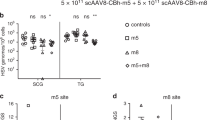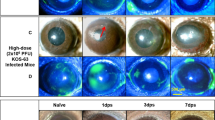Abstract
To create an oncolytic herpes simplex virus type 1 (HSV-1) that is inhibited for reactivation, we constructed a novel herpes recombinant virus with deletions in the γ34.5 and LAT genes. The LAT gene was replaced by the gene for green fluorescent protein, thereby allowing viral infection to be followed. This virus, designated DM33, is effective in killing primary and established human glioma cell lines in culture. DM33 is considerably less virulent following intracerebral inoculation of HSV-susceptible BALB/c mice than the wild-type HSV-1 strain McKrae. The safety of this virus is further supported by the retention of its sensitivity to ganciclovir and its relatively limited toxicity against cultured human neuronal cells, astrocytes, and endothelial cells. The ability of DM33 to spontaneously reactivate was tested in a rabbit ocular infection model that accurately depicts human herpes infection and reactivation. Following ocular infection of rabbits, spontaneous reactivation was detected in 83% (15/18) of the eyes infected with wild-type McKrae. In contrast, none of the eyes infected with DM33 had detectable reactivation. The efficacy of this virus in cultured human glioma cell lines, its safety, confirmed by its inability to reactivate, and its attenuated neurovirulence make DM33 a promising oncolytic agent for tumor therapy. Cancer Gene Therapy (2001) 8, 269–277
This is a preview of subscription content, access via your institution
Access options
Subscribe to this journal
Receive 12 print issues and online access
$259.00 per year
only $21.58 per issue
Buy this article
- Purchase on Springer Link
- Instant access to full article PDF
Prices may be subject to local taxes which are calculated during checkout
Similar content being viewed by others
References
Fine HA, Dear KB, Loeffler JS, Black PM, Canellos GP . Meta-analysis of radiation therapy with and without adjuvant chemotherapy for malignant gliomas in adults Cancer 1993; 71:: 2585–2597
Coen DM, Kosz-Vnenchak M, Jacobsen JG, et al . Thymidine kinase–negative herpes simplex virus mutants establish latency in mouse trigeminal ganglia but do not reactivate Proc Natl Acad Sci USA 1989; 86:: 4736–4740
Martuza RL, Malick A, Markert JM, Ruffner KL, Coen DM . Experimental therapy of human glioma by means of a genetically engineered virus mutant Science 1991; 252:: 854–856
Goldstein DJ, Weller SK . Herpes simplex virus type 1–induced ribonucleotide reductase activity is dispensable for virus growth and DNA synthesis: isolation and characterization of an ICP6 lacZ insertion mutant J Virol 1988; 62:: 196–205
Mineta T, Rabkin SD, Martuza RL . Treatment of malignant gliomas using ganciclovir-hypersensitive, ribonucleotide reductase–deficient herpes simplex viral mutant Cancer Res 1994; 54:: 3963–3966
Chou J, Kern ER, Whitley RJ, Roizman B . Mapping of herpes simplex virus-1 neurovirulence to gamma 134.5, a gene nonessential for growth in culture Science 1990; 250:: 1262–1266
Markert JM, Malick A, Coen DM, Martuza RL . Reduction and elimination of encephalitis in an experimental glioma therapy model with attenuated herpes simplex mutants that retain susceptibility to acyclovir Neurosurgery 1993; 32:: 597–603
Kramm CM, Chase M, Herrlinger U, Jacobs A, Pechan PA, Rainov NG, Sena-Esteves M, Aghi M, Barnett FH, Chiocca EA, Breakefield XO . Therapeutic efficiency and safety of a second-generation replication — conditional HSV1 vector for brain tumor gene therapy Hum Gene Ther 1997; 8:: 2057–2068
Mineta T, Rabkin SD, Yazaki T, Hunter WD, Martuza RL . Attenuated multimutated herpes simplex virus-1 for the treatment of malignant gliomas Nat Med 1995; 1:: 938–943
Nesburn AB, Elliott JH, Leibowitz HM . Spontaneous reactivation of experimental herpes simplex keratitis in rabbits Arch Ophthalmol 1967; 78:: 523–529
Perng GC, Thompson RL, Sawtell NM, Taylor WE, Slanina SM, Ghiasi H, Kaiwar R, Nesburn AB, Wechsler SL . An avirulent ICP34.5 deletion mutant of herpes simplex virus type 1 is capable of in vivo spontaneous reactivation J Virol 1995; 69:: 3033–3041
Perng GC, Dunkel EC, Geary PA, Slanina SM, Ghiasi H, Kaiwar R, Nesburn AB, Wechsler SL . The latency-associated transcript gene of herpes simplex virus type 1 (HSV-1) is required for efficient in vivo spontaneous reactivation of HSV-1 from latency J Virol 1994; 68:: 8045–8055
Perng GC, Slanina SM, Yukht A, Ghiasi H, Nesburn AB, Wechsler SL . The latency-associated transcript gene enhances establishment of herpes simplex virus type 1 latency in rabbits J Virol 2000; 74:: 1885–1891
Perng GC, Ghiasi H, Kaiwar R, Nesburn AB, Wechsler SL . An improved method for cloning portions of the repeat regions of herpes simplex virus type 1 J Virol Methods 1994; 46:: 111–116
Perng GC, Ghiasi H, Slanina SM, Nesburn AB, Wechsler SL . High-dose ocular infection with a herpes simplex virus type 1 ICP34.5 deletion mutant produces no corneal disease or neurovirulence yet results in wild-type levels of spontaneous reactivation J Virol 1996; 70:: 2883–2893
Perng GC, Ghiasi H, Slanina SM, Nesburn AB, Wechsler SL . The spontaneous reactivation function of the herpes simplex virus type 1 LAT gene resides completely within the first 1.5 kilobases of the 8.3-kilobase primary transcript J Virol 1996; 70:: 976–984
Andreansky S, Soroceanu L, Flotte ER, Chou J, Markert JM, Gillespie GY, Roizman B, Whitley RJ . Evaluation of genetically engineered herpes simplex viruses as oncolytic agents for human malignant brain tumors Cancer Res 1997; 57:: 1502–1509
Chambers R, Gillespie GY, Soroceanu L, Andreansky S, Chatterjee S, Chou J, Roizman B, Whitley RJ . Comparison of genetically engineered herpes simplex viruses for the treatment of brain tumors in a scid mouse model of human malignant glioma Proc Natl Acad Sci USA 1995; 92:: 1411–1415
Brown SM, Harland J, Maclean AR, Podlech J, Clements JB . Cell type and cell state determine differential in vitro growth of non-neurovirulent ICP34.5-negative herpes simplex virus type 1 and 2 J Gen Virol 1994; 75:: 2367–2377
Bolovan CA, Sawtell NM, Thompson RL . ICP34.5 mutants of herpes simplex virus type 1 and strain 17syn+ are attenuated for neurovirulence in mice and for replication in confluent primary mouse embryo cell cultures J Virol 1994; 68:: 48–55
Sundaresan P, Hunter WD, Martuza RL, Rabkin SD . Attenuated, replication-competent herpes simplex virus type 1 mutant G207: safety evaluation in mice J Virol 2000; 74:: 3832–3841
Author information
Authors and Affiliations
Corresponding author
Rights and permissions
About this article
Cite this article
Samoto, K., Perng, GC., Ehtesham, M. et al. A herpes simplex virus type 1 mutant deleted for γ34.5 and LAT kills glioma cells in vitro and is inhibited for in vivo reactivation. Cancer Gene Ther 8, 269–277 (2001). https://doi.org/10.1038/sj.cgt.7700306
Published:
Issue Date:
DOI: https://doi.org/10.1038/sj.cgt.7700306
Keywords
This article is cited by
-
Oncolytic herpes simplex virus and immunotherapy
BMC Immunology (2018)
-
Attenuated phenotypes and analysis of a herpes simplex virus 1 strain with partial deletion of the UL7, UL41 and LAT genes
Virologica Sinica (2017)
-
Advance in herpes simplex viruses for cancer therapy
Science China Life Sciences (2013)
-
Evidence for involvement of ROCK signaling in bradykinin-induced increase in murine blood–tumor barrier permeability
Journal of Neuro-Oncology (2012)
-
Increasing of Blood-tumor Barrier Permeability through Paracellular Pathway by Low-frequency Ultrasound Irradiation In Vitro
Journal of Molecular Neuroscience (2011)



